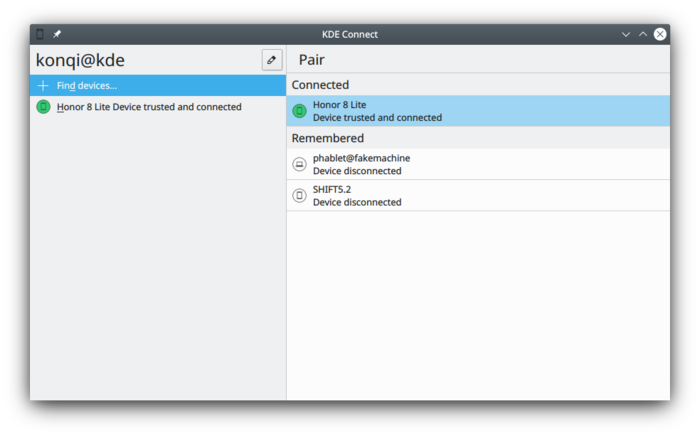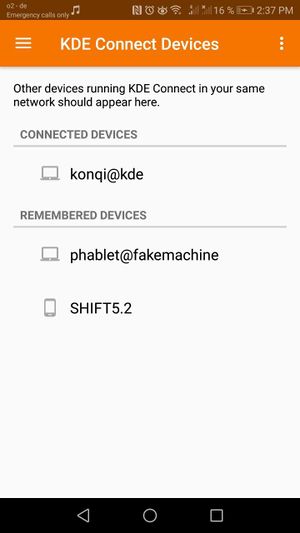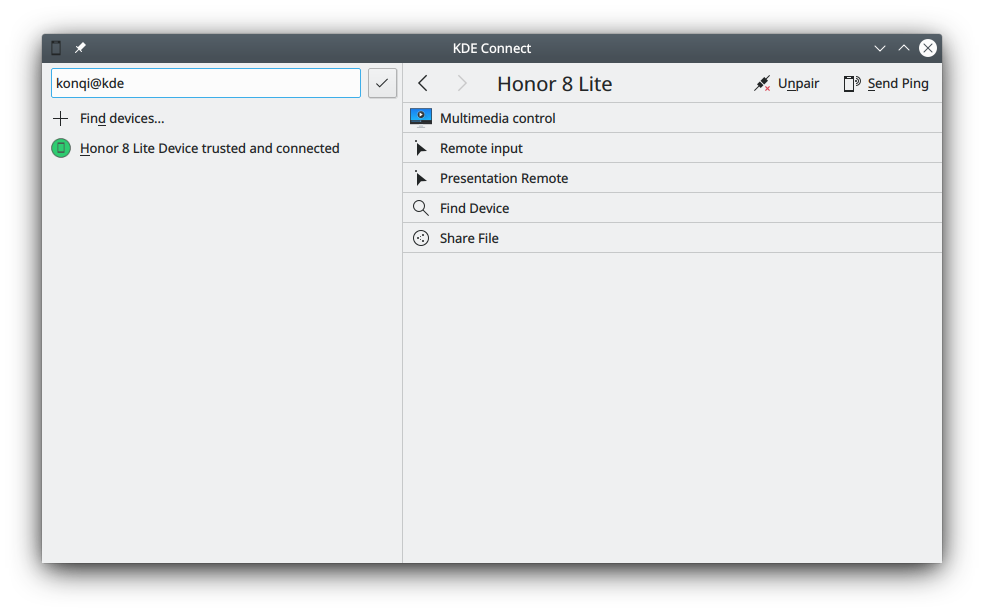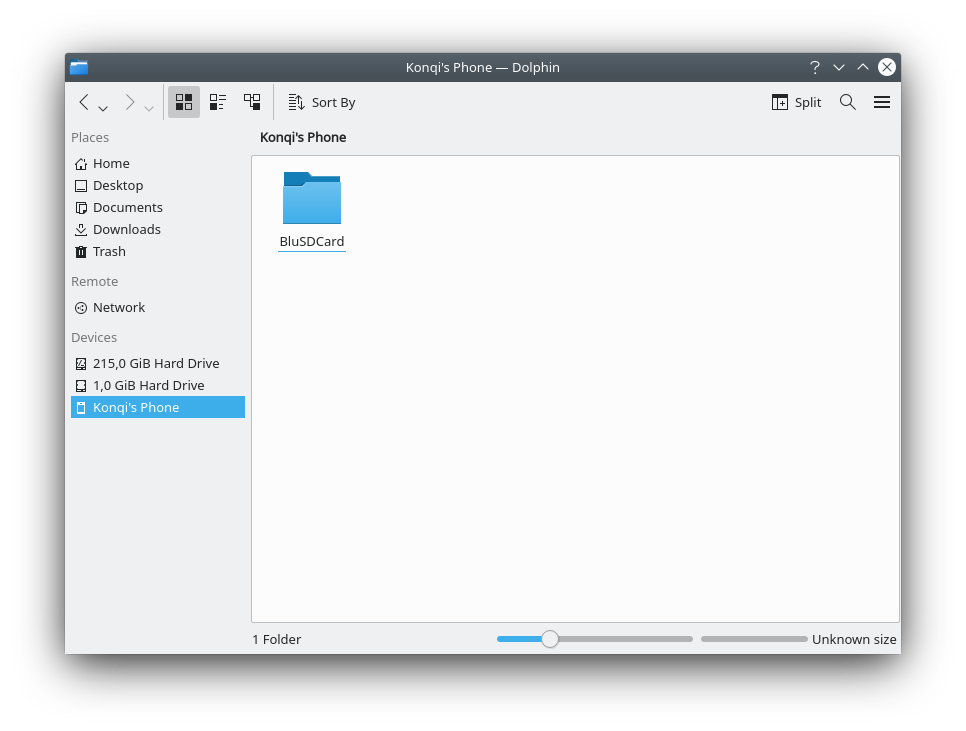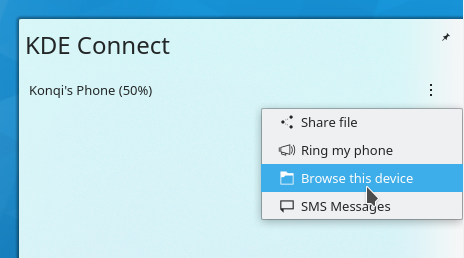- Как установить kdeconnect в Ubuntu / Debian
- Установка:
- Подробная информация о пакете:
- Зависимости:
- KDEConnect
- Contents
- What is KDE Connect?
- Installation and Usage
- Build KDE Connect from source
- Linux Desktop
- Using a meta-build system
- Without a meta-build system
- Windows
- Android
- MacOS
- Special Mentions
- Plasmoid Development
- Mobile-Friendly QML App
- Desktop SMS Messaging App
- Development
- Setting up KDE Connect Repository for Development
- Set up second remote (Optional)
- Development tips
- Restarting the daemon
- Debug Logging
- DBus inspection
- Running KDE Connect on an emulator
- Release Process
- C++ Application
- Tarballs
- KDEConnect
- Содержание
- What is KDE Connect?
- Installation
- Overview
- Pairing two devices together
- Browser Integration
- Changing Device Names
- Running KDE Connect over OpenVPN
- Set up OpenVPN
- Configure KDE Connect
- Available Plugins
- Battery Monitor
- Clipboard
- Inhibit Screensaver
- Multimedia Control Receiver
- Pause Media During Calls
- Receive Notifications
- Remote File System Browser
- Ring My Phone
- Run Commands
- Send Notifications
- Share and Receive
- Telephone Integration
- Virtual Input
- Presentation control
- Troubleshooting
- I have two devices running KDE Connect on the same network, but they can’t see each other
- firewalld
- Firewall Configuration (firewall-config)
- iptables
- KDE Connect crashes or restarts when trying to pair with another device
- KDE Connect Android app crashes
- Can I run KDE Connect without a display server?
- GSConnect
- My problem is not in this list 🙁
Как установить kdeconnect в Ubuntu / Debian
Установка:
Для установки kdeconnect в Ubuntu / Linux Mint / Debian, введите в Терминал :
Подробная информация о пакете:
Подключите смартфоны к вашему рабочему пространству KDE Plasma
Зависимости:
Инструменты для использования служб KDE из командной строки
Абстракция ресурсов и сетевого доступа
Библиотека GNU C: общие библиотеки
Библиотека для преобразования символов в X нажатие клавиш [время выполнения]
Библиотека поддержки GCC
Структура настроек конфигурации для Qt
Дополнительные виджеты для упрощения конфигурации.
KDE Frameworks 5 дополнений к QtCore
Библиотека классов для qtdbus
Дополнительные API для написания модулей KConfig.
Абстракция ресурсов и сетевого доступа
Абстракция ресурсов и сетевого доступа
Абстракция ресурсов и сетевого доступа
Фреймворк для уведомлений на рабочем столе
Расширенная интроспекция плагинов и сервисов
Расширенная интроспекция плагинов и сервисов
Оболочка библиотеки Qt для библиотек Wayland
Дополнительные виджеты и классы для приложений, использующих модуль Qt Widgets
Библиотеки для криптографической архитектуры Qt
Плагины QCA для libqca2
Модуль ядра Qt 5
Модуль D-Bus Qt 5
Модуль Qt 5 GUI
Сетевой модуль Qt 5
Модуль виджетов Qt 5
Qt 5 X11 Дополнительно
Стандартная библиотека GNU GNU v3
X11 клиентская библиотека
X11 Testing — библиотека расширений записи
Qt 5 Модуль быстрого управления QML
Qt 5 Qt Quick Controls 2 Модуль QML
Qt 5 Quick Layouts QML-модуль
Qt 5 Qt Quick 2 QML-модуль
Клиент файловой системы на основе протокола SSH File Transfer Protocol
Источник
KDEConnect
This is the community page for KDE Connect. Feel free to edit it! It should contain useful and up-to-date resources for both users and developers.
Contents
What is KDE Connect?
KDE Connect is a project that enables all your devices to communicate with each other. Here are a few things KDE Connect can do:
- Receive your phone notifications on your desktop computer and reply to messages
- Control music playing on your desktop from your phone
- Use your phone as a remote control for your desktop
- Run predefined commands on your PC from connected devices. See the list of example commands for more details.
- Check your phones battery level from the desktop
- Ring your phone to help finding it
- Share files and links between devices
- Browse your phone from the desktop
- Control the desktop’s volume from the phone
To achieve this, KDE Connect:
- implements a secure communication protocol over the network, and allows any developer to create plugins on top of it.
- Has a component that you install on your desktop.
- Has a KDE Connect client app you run on your phone.
This video from 2013 demonstrates some other cool features: https://www.youtube.com/watch?v=KkCFngNmsh0
More info at Albert Vaka’s or Nico’s blog.
Installation and Usage
Please see the KDE Connect Userbase page for detailed information on the different ways KDE Connect can be installed and used.
Build KDE Connect from source
KDE Connect is a free/ libre open source software, being developed for over 8 years now.
Linux Desktop
KDE Connect can be built directly from source using CMake and system-installed dependencies.
Alternatively, you may use a meta-build system like kdesrc-build or Craft, both of which have the added benefit of leaving your linux installation unaffected and containing the dev files to a single directory.
Using a meta-build system
- Craft is a cross-platform meta-build system that works quite well on Windows and Linux for KDE Connect devel.
- Set up Craft using this link, and then visit here for instructions to use Craft to build KDE Connect.
- kdesrc-build is a meta-build system that is used by many long-term KDE developers as their daily driver for KDE devel on Linux. See here for comprehensive build instructions.
Without a meta-build system
KDE Connect uses CMake as its build system, which will tell you if you are missing any dependencies. See here for build instructions.
Windows
KDE Connect is officially supported on Windows. See here for build instructions.
Android
The most convenient dev-flow way is to pass the project URL to Android Studio, build the app and install it to your phone. Remember to uninstall any already-installed KDE Connect app from your target Android device. You can also build the android app through CLI using gradle.
You can also run the app in an emulated Android device for devel. See [/Android_Emulator/ here] for instructions.
Since KDE Connect iOS is being developed in native frameworks, a recent version of Xcode is required to build the app. However, due to the special entitlements used in the complete version of KDE Connect, it can only be signed by the KDE e.V. development team. A wiki page is currently being written with information on how building and distribution would work and the possible resources available to contributors without macOS access.
MacOS
KDE Connect works fairly well on macOS, however there is no official version as of yet. See here for build instructions.
You can get the Nightly Build from the Binary Factory.
Special Mentions
Special instructions for specfic topics.
Plasmoid Development
You can use plasmawindowed to easily run the Plasmoid (even on non-KDE environments).
Set up your dev environment as above, then run make install , then run plasmawindowed org.kde.kdeconnect to launch the Plasmoid and see your changes.
Mobile-Friendly QML App
The kdeconnect-app component of the desktop version is suitable for mobile Linux environments, too.
Desktop SMS Messaging App
KDE Connect has an SMS messaging app which lets you type and view SMS messages from your computer. It supports basic features and works correctly most of the time. If you are interested in trying or developing it, you can build it from source. It is automatically built as part of the rest of KDE Connect and is output as ‘kdeconnect-sms’.
Development
KDE Connect is a perfect project to start contributing to KDE. You’ll need a basic understanding of programming concepts, the rest can be learned by doing. Experience with Android or Qt is beneficial, but not needed.
We have a group to discuss development. You can access it from Telegram, IRC (#kdeconnect) or matrix.org (#freenode_#kdeconnect:matrix.org). Feel free to ask any development-related questions there. We also have a mailing list.
All patches are submitted on Gitlab. The Android repository is here and the C++ Desktop repository is here. Be sure to select the most relevant template. You don’t need to assign any reviewers, the developers are subscribed to notifications. Should this be your first patch, it’s good to know that it might take some time before your patch is reviewed (we all work on KDE Connect in our free time), and you’ll probably have to make some changes a couple of times. That’s not because you’re new, that’s what happens for all reviews (even for long-time contributors).
There are a couple of tasks marked as Junior Jobs on our workboard. Those have some extra information on how to approach them that help you get started.
Setting up KDE Connect Repository for Development
KDE Connect is actually composed of two repositories; one for the Android implementation and one for the C++ (Desktop) implementation. You can have a local clone of both on your computer and the steps to set them up are the same. For these directions, I will use the C++ repository, but if you want the Android repository, just replace every instance of ‘kdeconnect-kde’ with ‘kdeconnect-android’
- Fork the repository
- With your web browser, open the Web GUI to KDE Connect’s GitLab: https://invent.kde.org/network/kdeconnect-kde
- If you are not already, sign in with your KDE identity by clicking the «Sign In» button in the top left
- Click the «Fork» button, near the top right
- Wait for the forking to complete
- Clone your fork
- Open your new fork in the GitLab web GUI
- Click the «Clone» button in the top right
- Select the method of cloning
- I recommend SSH. This will require you add an SSH public key to your KDE GitLab account.
- An HTTPS clone will require you to log in with your KDE Identity credentials to push changes.
- In the folder you want to clone, do ‘git clone ‘
You are all set up! See the optional steps for ways to make life easier.
Set up second remote (Optional)
Having a second remote allows you to have your local ‘master’ branch track the upstream kdeconnect-kde master branch, so you can easily get all the latest changes.
These steps assume you are using command-line git. If you are using a GUI tool, the steps will be different, but the ideas will be the same.
- On the command line, change to your local repository clone
- Execute:
- Now whenever there are new changes upstream, simply pull the upstream-master branch, then merge or rebase your local branches onto those changes!
Development tips
Restarting the daemon
Whenever you do a change to KDE Connect you need to restart the daemon for the change to take effect.
Debug Logging
By default, most Linux distributions tell Qt to restrict what logging you will see. You can control this using the QT_LOGGING_RULES variable. Running something like the below command will show most all logging.
DBus inspection
The daemon communicates with various UI components (Plasmoid, CLI, Indicator etc.) over DBus. QDbusViewer allows inspecting the DBus interface provided by the daemon which can be incredibly useful for debugging.
Running KDE Connect on an emulator
How to setup running KDE Connect on an emulator is described here Android_Emulator
Release Process
The following sections describe how to release a new version KDE Connect
C++ Application
Tarballs
Tarball releases are handled automatically through KDE’s release process. These are typically consumed by downstream distros in their release process.
Источник
KDEConnect
Содержание
What is KDE Connect?
KDE Connect is a project that enables all your devices to communicate with each other. Here’s a few things KDE Connect can do:
- Receive your phone notifications on your desktop computer and reply to messages
- Control music playing on your desktop from your phone
- Use your phone as a remote control for your desktop
- Run predefined commands on your PC from connected devices. See the list of example commands for more details.
- Check your phone’s battery level from the desktop
- Ring your phone to help find it
- Share files and links between devices
- Browse your phone from your desktop
- Control the desktop’s volume using your phone
- Send SMS from your desktop
Installation
You will most likely find the KDE Connect desktop component as a package in your distribution’s repos. If not, you can ask them to package it.
Despite common misconception, you can use KDE Connect on all desktop environments. Since most of the developers are using Plasma, it may occur that a feature is broken or inaccessible on other desktop environments. In this case, please file a bug report. There are multiple ways to enhance the KDE Connect experience on non-Plasma desktops. If you are a GNOME user you might prefer GSConnect, a GNOME shell extension. For desktops with AppIndicator support (Budgie, Cinnamon, LXDE, Pantheon, Unity) indicator-kdeconnect is available.
The app for Android can be found in both the Google Play Store and the free and open store F-Droid.
There was some development of a KDE Connect client app for iOS in 2014 (see source code) which sat still for a couple of years until it was picked up again in around 2018-19 with a couple of patches and TLS support. In 2021, a major project was started to revamp much of the old codebase with newer frameworks and possibilities of further expansion.
KDE Connect is also available on [1] and we are working on bringing it to other Linux-based phones (Plasma Mobile, PostmarketOS etc.)
Overview
This is the documentation page for KDEConnect. You can see the community page here [2] which explains what KDEConnect is and how to install it.
KDE Connect has two parts. The desktop program and the phone app.
Pairing two devices together
First, you need to open KDE Connect on your computer and phone. You should now be able to see in each screen the name of the device you wish to pair with. If it’s working, make sure that the two devices are connected to the same network and that there isn’t any firewall blocking the two devices from seeing each other. See the troubleshooting section.
You can now request pairing in one of the two devices. The other device will show a prompt asking to accept the pairing request. Confirm it and that’s it! Your devices are now paired.
While a typical configuration might include one computer and one phone, it’s also possible to pair two computers instead.
Browser Integration
Plasma Browser Integration makes KDE Connect even more powerful. It allows you to control content from e.g. Youtube or Netflix from your phone and send browser tabs to your phone. Despite the name, it can also be used on non-Plasma desktops.
Changing Device Names
You can only change the name of your device on the device itself. So if you want to change the name of your computer then you must use the desktop program and if you want to change the name of your phone or tablet you must make the change in the KDE Connect app. Once a device is renamed, it will automatically sync with all other connected devices.
Running KDE Connect over OpenVPN
There may be a variety of reasons for using KDE Connect with a VPN. Maybe you have left home and want to run a command, or maybe you’re on a public wifi network where your devices aren’t allowed to communicate and you want to use the remote control to give a presentation.
Set up OpenVPN
If you have your own server with a public-facing IP address, you can set up OpenVPN yourself. It is not the easiest piece of software to set up, but by following a setup tutorial such as this one, you should be able to manage: https://openvpn.net/howto.html
In order to allow UDP broadcast packets, which are what KDE Connect uses to automatically discover two devices, OpenVPN needs to be set up for bridging (TAP device). If you use a tun device, you can still manually connect by IP address.
If you want to rent a pre-configured OpenVPN service rather than set up your own, it should work, but the same considerations about the server settings need to be taken into account.
Once the server is running, you can use the official OpenVPN client to connect the desktop to the server. There is no official OpenVPN client for Android, but the OpenVPN for Android client works well: https://play.google.com/store/apps/details?id=de.blinkt.openvpn
Once both devices are connected, test that they are able to communicate over the VPN by trying to do a network ping between them.
Configure KDE Connect
If your OpenVPN instance is set up for bridging, KDE Connect should work just like on a local network.
If you are using OpenVPN with a tun device, you will have to manually add your devices by IP. Then, once you connect to the VPN, KDE Connect should automatically detect your device and either connect or be ready for pairing!
Available Plugins
Battery Monitor
«Show your phone battery next to your computer battery.»
By enabling this, the KDE Connect widget on your panel tray will display your phone’s battery.
Clipboard
«Share the clipboard between devices.»
With this, you can simply copy text from your computer and it will be immediately available to paste on your phone, and vice-versa. This does not work with images though.
Inhibit Screensaver
«Inhibit the screensaver when the device is connected.»
This makes sure that your screensaver will not run while your device is connected.
Multimedia Control Receiver
«Remote control your music and videos.»
With this feature, you can control your music and videos remotely, with pause/play, previous/next, 5 s before/later. You can also change which media player to control, in addition to application and system volume.
Pause Media During Calls
«Pause music/videos during a phone call.»
Pause music/videos during a call. This feature can be powerful when combined with Plasma Browser Integration. For example, when you are listening to some music on Peertube or Youtube, the video will be paused whenever you receive a call.
You can configure this option to pause only when you pick up your phone or directly when your phone starts to ring. You can also decide if you want to only pause the media player or/and mute the system sound.
«Send and receive pings.»
This serves to test your connection to a given device. Once selected, a «Ping!» will appear as a notification on your receiving device.
On your desktop, you can send a ping through the KDE Connect settings or through the widget on the tray.
On your phone, you can send a ping through the upper right hamburger menu on the KDE Connect app.
Receive Notifications
«Show your phone notifications on your computer and keep them in sync.»
This keeps you in touch with what happens on your phone! Any notifications you receive on your phone will be shown in your computer. Some notifications, such as those of Instant Messengers (IM) like Telegram can be replied on the fly through the computer notification itself.
Remote File System Browser
«Browse the remote device filesystem using SFTP.»
This allows you to access your phone storage! When enabled, a device will appear in Dolphin with which you can navigate your external storage.
Ring My Phone
«Find your lost phone by making it play an alarm sound.»
This also serves to test your connection to a given device, and by ringing your phone remotely, you can quickly find its location!
Run Commands
«Execute console commands directly.»
With KDE Connect, you can run predefined commands on your computer by pressing buttons on your phone! Instructions on how to add a command are shown in userbase. A set of useful commands can also be found here. Some sample commands, such as suspend and lock screen, are also available.
Send Notifications
«Broadcast this computer’s notifications, so they can be shown on other devices.»
This is pretty self-explanatory: notifications from your computer will show up on your phone.
You can configure if you want to send the notification description, the icons pertaining to the application and persistent or very important notifications. This keeps you in touch with what happens on your computer! Any notifications you receive on your computer will be shown in your phone.
Share and Receive
«Receive and send files, URLs or plain text easily.»
This integrates your desktop and your browser so that you can right-click on files or links and send it immediately to your phone!
Files show the right-click option «Send to phone via KDEConnect» and will send the file directly, showing it among your notifications.
Links show the right-click option «Open on phone» and will automatically open your phone’s default browser on the chosen website. Really handy!
When receiving files from your phone into your computer, they will go to your Downloads folder by default. If you wish, you can change that too.
Telephone Integration
«Show notifications for incoming calls.»
Whenever you get a call on your phone, a notification telling you which number is calling appears. Paired with «Pause media during calls», you’ll surely be able to answer readily and never lose a call!
Virtual Input
«Use your phone as a touchpad and keyboard.»
With this enabled, by going to your phone app and selecting Remote input, a touch screen will immediately be available for you to control your computer mouse, similarly to a touchpad. One touch equals one click.
The keyboard icon in the upper right allows you to type on your phone and see the result on your computer too.
If you press the hamburger menu right by its side, you’ll be able to send right and middle clicks.
Presentation control
It is possible to control presentations using the previous/next slide button. When the device is locked, you can use the volume up/down button to do that. You can also highlight something using the laserpointer. Just move your phone and the blue circle will follow! Using the hamburger menu, you can toggle fullscreen (F5) or quit the presentation (Esc).
Troubleshooting
I have two devices running KDE Connect on the same network, but they can’t see each other
KDE Connect uses dynamic ports in the range 1714-1764 for UDP and TCP. So if you are behind a firewall, make sure to open this port range for both TCP and UDP. Otherwise, make sure your network is not blocking UDP broadcast packets.
If your firewall is ufw, you can open the necessary ports with:
firewalld
If your firewall is firewalld, you can open the necessary ports with:
Firewall Configuration (firewall-config)
Open Firewall Configuration ( firewall-config ). In Zones ➔ Services, check the kde-connect service.
Make sure you choose the «Permanent» Configuration: option in the drop-down menu at the top, otherwise rebooting will discard your settings changes.
iptables
If your firewall is iptables, you can open the necessary ports with:
KDE Connect crashes or restarts when trying to pair with another device
Sometimes, a corrupt config file may cause KDE Connect to crash when trying to pair with a device. In that case, deleting the config
/.config/kdeconnect might help.
KDE Connect Android app crashes
If the KDE Connect Android app crashes, you might be able to get more information about the crash by using adb logcat.
The following command should list all information relevant to your crash. Run adb logcat *before* triggering the crash.
Can I run KDE Connect without a display server?
Yes, you can pass the command line argument `-platform offscreen` to the daemon (eg: `killall -9 kdeconnectd; /usr/lib/libexec/kdeconnectd -platform offscreen`)
GSConnect
GSConnect is an independent project which implements the KDE Connect protocol into GNOME and uses the same Android app. If you are running GSConnect, please visit that project’s GitHub page first for support. If you and the GSConnect team determine the issue is the Android app or protocol, feel free to report those in the KDE Connect bug tracker.
My problem is not in this list 🙁
In case you find a bug and want to report it, you can do so in the KDE bug tracker.
Источник

